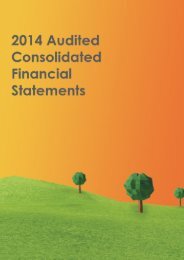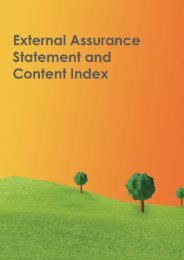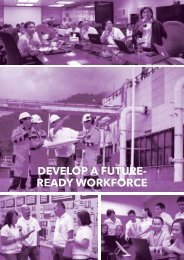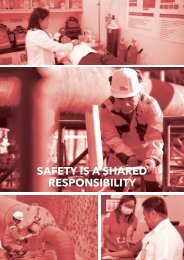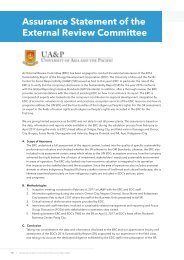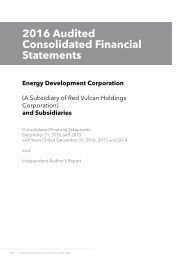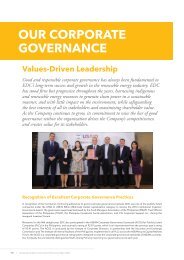EDC 2014 SR (UPDATED)
You also want an ePaper? Increase the reach of your titles
YUMPU automatically turns print PDFs into web optimized ePapers that Google loves.
<strong>EDC</strong> <strong>2014</strong> Performance Report<br />
Also, the Board approved our Enterprise Risk Management (ERM) Manual, which aims to establish a common risk language that will enable a<br />
dynamic and consistent application of risk management initiatives, aligned with ISO 31000:2009 (Risk Management – Principles and Guidelines), on 1<br />
December <strong>2014</strong>. Based on our ERM Manual, the RMC approves our risk appetite to guide the establishment of the risk tolerances based on physical<br />
injuries, environmental damage, reputation and financial impact. Once risks are identified, risk management strategies and plans are formulated,<br />
implemented, monitored and reviewed. This is consistent with what we have been currently been doing.<br />
Key risks. Our risk management activities are performed in three different levels with corresponding risk owners as shown in Figure 4 below of our<br />
Enterprise Risk Management Manual:<br />
Level of Enterprise Risk Management and Ownership<br />
Management Level level of erm ownership<br />
BOD<br />
Senior<br />
Management<br />
Strategic Risks<br />
Risk Management Committee/<br />
Management Committee<br />
Line Management<br />
Operational Risks<br />
Strategic Business Units/<br />
Centers of Excellence<br />
Project<br />
Project Risks<br />
Project Teams<br />
a)<br />
b)<br />
c)<br />
Strategic Risks. Our ERM Manual defined strategic risks as those risks, whether internal or external, that significantly affect the accomplishment<br />
of the corporate short-term and long-term objectives. These are possible sources of loss due to adverse business decisions, improper<br />
implementation of plans, or lack of responsiveness to industry changes.<br />
<strong>EDC</strong>’s strategic risk management is integrated into the overall business strategy and planning processes, so that the risk management<br />
programs support the development and execution of the business strategy. It is a CEO and Board-level priority, wherein the objectives are<br />
to distill insights and provide clarity on the top 5 to 10 most important risks shaping <strong>EDC</strong>’s performance; to support risk-informed decisions<br />
at the RMC-level; to ensure a risk dialogue among the Management Committee, so that strategic risks can be prioritized according to their<br />
impact and likelihood of occurrence; and to enable proper risk oversight by the Board.<br />
Operational Risks. As provided in our ERM Manual, operational risks are those risks due to changes and circumstances in the internal and<br />
external environments that may affect <strong>EDC</strong>’s way of doing business. These are the possible sources of loss due to inadequate or failed<br />
internal processes, people or system, or from external events such as natural calamities.<br />
To prevent the risk of business interruption, our asset management are continuously being implemented, evaluated and strengthened.<br />
Business Continuity and Crisis Management Plans are also being developed to improve resilience. Lastly, business interruption insurance<br />
can be obtained to cover the potential revenue loss during an operational risk event. By doing these, the top management, through the<br />
Management Committee, are connected with the rest of the organization on operational risk matters to ensure that critical risk information<br />
will surface in a timely manner.<br />
Project risks. Our ERM Manual define project risks as an uncertain event that, if it occurs, has a positive or negative effect on the project’s<br />
progress, result or outcome. Project risk management is a continuous part of <strong>EDC</strong>’s governance, and are embedded throughout the life<br />
cycle of every project as it is in the daily operation of the business. Generally, project risks are managed by building risk management into<br />
the project life cycle, ensuring that a process is in place to identify, prepare for and mitigate risks; developing project contingency plans;<br />
actively promoting risk-based mindset within the Project Team; anticipating and mitigating post-project risks which may impact business<br />
as usual.<br />
In <strong>2014</strong>, our RMC continued to strengthen our risk management system to handle strategic and operational risks in order to achieve our business<br />
objectives.<br />
This page contains the following GRI indicator(s):<br />
G4-2, G4-12, G4-51, G4-52, G4-53.<br />
101




